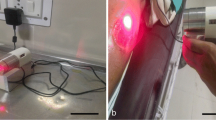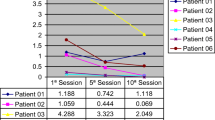Abstract
Aim
Debridement of fibrin and necrotic tissue from the ulcer surface is an important component of the treatment of diabetic ulcers. A possible alternative to standard lancets is represented by CO2 laser, which vaporizes necrotic tissues together with any pathogen. The present trial is aimed at verifying the effect of a CO2 laser on bacterial load in the debridement of infected diabetic foot ulcers.
Methods
In this open-label randomized controlled trial (NCT02677779), patients with diabetes and an infected foot ulcers were randomized to either CO2 laser or traditional debridement.
Results
The reduction (%) of bacterial load with CO2 laser was significantly greater than in control group [−99.9 (−100.0; −90.0) vs. −50.0 (−96.0; −75.0), p = 0.049]. Similarly, a significantly greater reduction (%) of the fraction of ulcer area covered by fibrin was obtained in the intervention group [−84.1 (−95.0; −72.2) vs. −46.9 (−69.5; −40.8), p = 0.038].
Conclusions
Debridement of ulcers with CO2 laser significantly reduces bacterial load and fibrin-covered areas, and could be of help in the treatment of diabetic foot ulcer.

Similar content being viewed by others
References
European Wound Management Association (EWMA) (2004) Position document: wound bed preparation in practice. MEP Ltd, London. http://www.ewma.org
Libon J, Funkhouser W, Terris DJ (1997) A comparison of mucosal incisions made by scalpel, CO2 laser, electrocautery, and constant-voltage electrocautery. Otolaryngol Head Neck Surg 116:379–385
Bruce Reid A, Stranc MF (1991) Healing of infected wounds following Iodine scrub or CO2 laser treatment. Laser in Surgery Medicine 11:475–480
Manolis EN, Tsakris A, Kaklamandos I, Markogiannakis A, Siomos K (2006) In vivo effect of carbon dioxide laser-skin resurfacing and mechanical abrasion on the Skin’s microbial flora in an animal model. Dermatologic Surg 32:359–364
Whinfield AL, Aitkenhead I (2009) The light revival: does phototherapy promote wound healing? A review. Foot (Edinb) 19:177–224
Sanders DL, Reinish L (2000) Wound healing and collagen thermal damage in 7.5-µs pulsed CO2 laser skin incisions. Lasers Surg Med 26:22–32
Tchanque-Fossuo CN, Ho D, Dahle SE, Koo E, Li CS, Rivkah Isseroff R, Jagdeo J (2016) A systematic review of low-Level light therapy for treatment of diabetic foot ulcer. Wound Repair Regen (Epub ahead of print)
Feitosa MC, Carvalho AF, Feitosa VC, Coelho IM, Oliveira RA, Arisawa EÂ (2015) Effects of the low-level laser therapy (LLLT) in the process of healing diabetic foot ulcers. Acta Cir Bras 30:852–857
Apelqvist J, Bakker K, van Houtum WH, Nabuurs-Franssen MH, Schaper NC (2000) International consensus and practical guidelines on the management and the prevention of the diabetic foot. International Working Group on the Diabetic Foot. Diabetes Metab Res Rev 16:S84–S92
Caraceni A, Mendoza TR, Mencaglia E, Baratella C, Edwards K, Forjaz MJ, Martini C, Serlin RC, de Conno F, Cleeland CS (1996) A validation study of an Italian version of the Brief Pain Inventory (Breve Questionario per la Valutazione del Dolore). Pain 65:87–92
Chromey PA (1992) The efficacy of carbon dioxide laser surgery for adjunct ulcer therapy. Clin Podiatr Med Surg 9:709–719
Reid AB1, Stranc MF (1991) Healing of infected wounds following iodine scrub or CO2 laser treatment. Lasers Surg Med 11:475–480
Lee JS, Tarpley SK, Miller AS 3rd. CO2 laser sterilization in the surgical treatment of infected median sternotomy wounds. South Med J 1999;92:380–384
Juri H, Palma JA (1987) CO2 laser in decubitus ulcers: a comparative study. Lasers Surg Med 7:296–299
Eliseenko VI, Skobelkin OK, Brekhov EI, Chegin VM, Degtriarev MK (1987) Microcirculation and angiogenesis during the healing of experimental purulent wounds exposed to a defocussed CO2 laser beam. Arkh Patol 49:50–54
Monami M, Mirabella C, Scatena A, Nreu B, Zannoni S, Aleffi S, Giannoni L, Mannucci E (2017) CO2 laser for the treatment of diabetic foot ulcers with exposed bone. A consecutive series of type 2 diabetic patients. J Endocrinol Invest. doi:10.1007/s40618-017-0642-x (Epub ahead of print)
Author contribution
MM and EM wrote the manuscript and enrolled patients. SA enrolled patients and reviewed the manuscript. CM and AS reviewed/edited the manuscript and contributed to the discussion. SZ contributed to the discussion and enrolled patients. LG contributed to discussion, enrolled patients, and reviewed the manuscript. MM is the guarantor of this work and, as such, had full access to all the data in the study and takes responsibility for the integrity of the data and the accuracy of the data analysis.
Author information
Authors and Affiliations
Corresponding author
Ethics declarations
Funding
This study was sponsored by DEKA S.p.a., Calenzano-Florence, Italy.
Conflict of interest
All other authors have no relevant conflict of interest to disclose.
Ethical standards
All procedures performed in studies involving human participants were in accordance with the ethical standards of the institutional and/or national research committee and with the 1964 Helsinki declaration and its later amendments or comparable ethical standards.
Human and animal rights
This article does not contain any studies with animals performed by any of the authors.
Informed consent
A formal informed consent was obtained for all participants.
Electronic supplementary material
Below is the link to the electronic supplementary material.
Rights and permissions
About this article
Cite this article
Monami, M., Scatena, A., Zannoni, S. et al. A randomized, open-label, controlled trial to evaluate the antimicrobial and surgical effect of CO2 laser treatment in diabetic infected foot ulcers: DULCIS (diabetic ulcer, CO2 laser, and infections) study. J Endocrinol Invest 40, 985–989 (2017). https://doi.org/10.1007/s40618-017-0666-2
Received:
Accepted:
Published:
Issue Date:
DOI: https://doi.org/10.1007/s40618-017-0666-2




